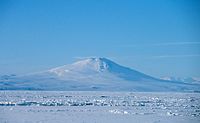
Photo from wikipedia
Abstract The small ice caps distributed across the Antarctic Peninsula region have undergone large ice volume changes since the Last Glacial Cycle, in line with most of the Antarctic continent.… Click to show full abstract
Abstract The small ice caps distributed across the Antarctic Peninsula region have undergone large ice volume changes since the Last Glacial Cycle, in line with most of the Antarctic continent. While the surface extent of glacial shrinking is relatively well known, the timing of glacial oscillations and the magnitude of ice thinning remain little investigated. Cosmic-Ray Exposure (CRE) dating applied on ice-free vertical sequences can provide insights about the temporal framework of glacial oscillations. However, the potential occurrence of nuclide inheritance may overestimate the real timing of the last glacial retreat. This problem has been observed in many areas in Continental Antarctica, but similar studies have not yet been conducted in environments of the Maritime Antarctica, such as the South Shetland Islands (SSI). This research focuses on the Hurd Peninsula ice cap (HPIC, ca. 60°22′ W, 62°40’ S), located in the SW of Livingston Island, SSI. Past climate oscillations since the Last Glacial Cycle have determined the amount of ice stored in the ice cap. Today, this polythermal ice cap is surrounded by several nunataks standing out above the ice. Three of them have been selected to explore their deglaciation history and to test the potential occurrence of nuclide inheritance in deglaciated bedrocks associated with polythermal glaciers. We present a new dataset with 10 10Be exposure dates. Some of them were found to be anomalously old, evidencing that nuclide inheritance is present in bedrocks associated with polythermal ice caps and suggesting complex glacial exposure histories. We attribute this to limited erosion, given the gentle slope of the nunatak margins and the cold-based character of the surrounding ice. The remaining samples allowed to approach local surface-elevation changes of the HPIC. Our results suggest that ice thinning started during the Last Glacial Maximum (LGM) at ∼22 ka but intense glacial shrinking occurred from ∼18 to ∼13 ka, when the nunataks became exposed, being particularly intense at the end of this period (∼14–13 ka) coinciding with the time of the meltwater pulse 1a (MWP-1a) and the end of the Antarctic Cold Reversal (ACR).
Journal Title: Quaternary Science Reviews
Year Published: 2021
Link to full text (if available)
Share on Social Media: Sign Up to like & get
recommendations!